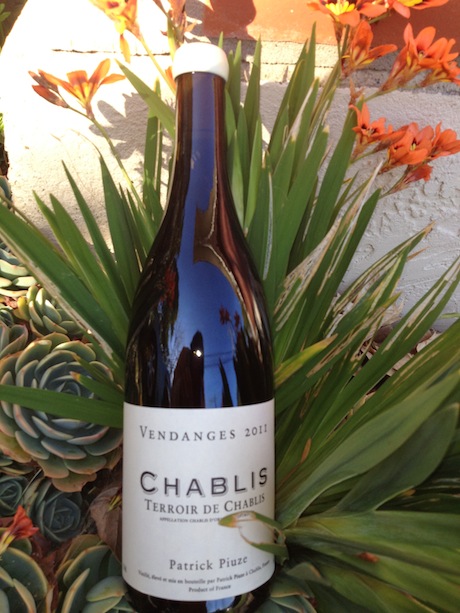French Wines: Patrick Piuze Terroir de Chablis 2011

Sat 13 Apr 2013
Patrick Piuze Terroir de Chablis 2011
Approximate retail price: $22–30
Available at major retailers such as the Wine House and Hi-Time Wine Cellars
As we well know, the French are extremely proud of their culture and traditions, especially when it comes to French wines and cuisine and the French language. Did you know, for example, that a law enacted in 1993 specifies that a traditional French baguette must be made of only flour, water, salt and yeast, and has to be baked on premises? According to Bloomberg news, this traditional baguette can only measure between 21.6 and 25.6 inches. Similarly, in order to protect French citizens from degenerating into franglais with anglicisms such as le weekend, the Conseil supérieur de la langue française came up with that ever-so-popular word la vacancelle.

So, how do the French feel about foreigners who attempt to produce French wines? Lucky for us, Québec native Patrick Piuze had no fear of protectionist policies. Since moving to Chablis, he has been embraced by his fellow Burgundian winemakers and is producing some terrifically tasty wines. It was actually a Frenchman from a wine-making family—Marc Chapoutier—who first introduced Patrick to the allure of wine, causing the young Piuze to work his way through wineries in Australia, South Africa and Israel before he moved back to Montreal to open his own wine bar. But the siren song of wine making continued to call, and in 2000, armed with only a backpack and dreams of French wine, Piuze moved to Burgundy to work with Olivier Leflaive, who promptly put the Canadian in charge of his Chablis winery operations. Eight years later, after his experience at O. Leflaive and ensuing positions at two Chablis domaines, Verget and Brocard, Piuze struck out on his own.
While Piuze doesn’t own any vineyards in Chablis, he certainly does a great job producing wines that bring each distinct terroir to life. What do we know about Chablis? Well, for starters, it’s 100 percent chardonnay. A dear friend of mine, herself a Quebecois, once asked me if chardonnay was always a white wine. Yes, ma belle poule, chardonnay is always white, and AOC regulations dictate that Chablis can be made only from 100 percent chardonnay grapes. Chablis was also once an ancient seabed, the precursor to its famed chalky, limestone soil full of marine fossils that arguably gives Chablis its clean, mineral, mouthwatering crispness.
Chardonnay has been much maligned as the “tofu” of wine; its detractors have argued that the grapes soak up and reflect only the flavors of new oak and malolactic fermentation, resulting in butter bombs more reminiscent of movie theater popcorn than divine wine. Fear not, my dears: Chablis is entirely on the opposite end of the spectrum, and the wines of Patrick Piuze not only stay firmly within those clean Chablis lines, but also do justice to the beauty of chardonnay.
In fact, while 95 percent of grapes in Chablis, including those from premier and grand cru vineyards, are today harvested by machine, Piuze harvests all of his grapes by hand, even at the village level. Furthermore, his village-level wines are not lumped into one generic Chablis label, but instead separated into four wines showcasing their separate terroir, of which this month’s wine, the Terroir de Chablis, is one. The grapes for Terroir de Chablis come from a vineyard just alongside one of the best premier cru vineyards in Chablis, les Forêts, and Piuze lets the purity of the fruit and soil shine, completely unadorned by any new oak. Though you might be tempted to sip too soon after taking the bottle from the fridge, you’ll be taken aback by its racy acidity, with notes of tart green apple and lime zest. As it warms up, it blossoms in the glass, revealing a touch of chamomile and stone fruit. The minerality lingers. This, mes amis, is a very pretty wine.
Pair it with raw oysters, and you’ll allow Chablis to come full circle, from its former seabed days to a perfect liquid companion to a creamy bivalve. Any shellfish would make a perfect pairing, but the acidity of the wine will also cut nicely through a buttery roast chicken or creamy pasta dish. Another traditional pairing would be with escargots in a delightfully sinful butter-and-garlic sauce. And who are we to break with tradition? As Piuze said once in an interview, “The only thing truly original in the world of wine is the underlying terroir, and I have nothing else to add. . . . I want to work only with the fruit from old vines and even then, only old vines that are planted exclusively within the original boundaries of Chablis.” Sometimes, it takes a foreigner to uphold French traditions.
Editor’s note: Food and wine lovers heading to Paris might want to try one of the Girls’ Guide’s favorite cooking classes in Paris.